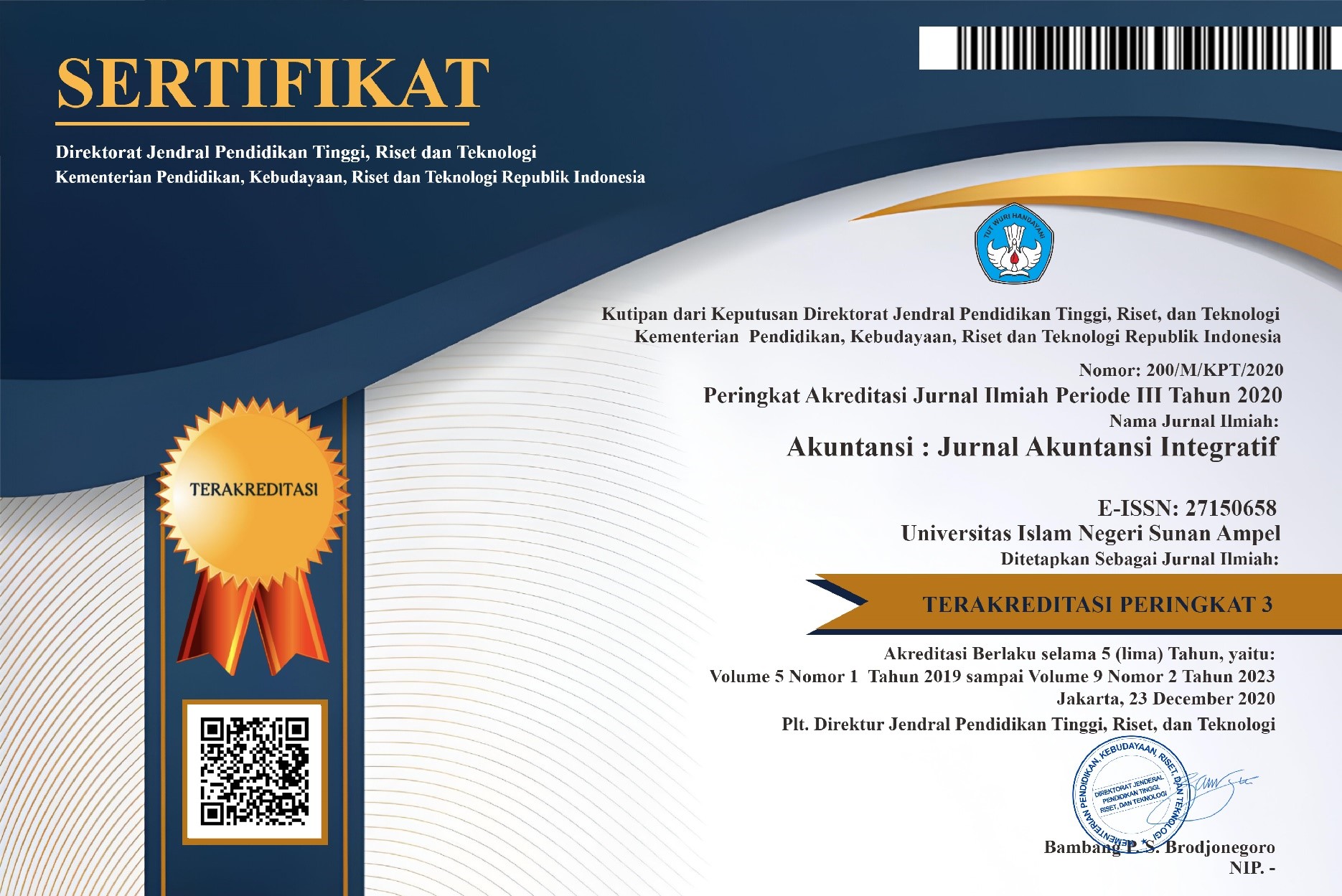Manajemen Laba, Tata Kelola Perusahaan, Persaingan Pasar Produk Terhadap Perilaku Sticky Cost Di Moderasi Kebijakan Insentif Pajak
DOI:
https://doi.org/10.29080/jai.v7i2.562Keywords:
Sticky Cost, Earnings Management, Corporate Governance, Product Market Competition, Tax IncentiveAbstract
Abstract
This purpose of this study was to determine the effect of earnings management, corporate governance, product market competition on sticky cost behavior by tax incentive policies. This research method uses a quantitative approach. The data collection technique is secondary data of annual financial reports on retail sub-sector companies listed on the Indonesia Stock Exchange for 2016-2020 a total of 28 companies. The samples were determined using purposive sampling. The data analysis method uses moderated regression analysis (MRA). The results of the study are earnings management, corporate governance have a positive and significant effect on sticky cost, and The tax incentive policy is able to moderate the relationship between corporate governance and sticky cost behavior. In this study, it helps to understand the cost behavior of retail sector companies, so it is expected that company management can more accurately estimate the value of the company in the future. The next research is expected to use a qualitative approach to expand studies related to research linking sticky cost behavior.
Downloads
References
Anderson, M. C., Banker, R. D., & Janakiraman, S. N. (2003). Are selling, general, and administrative costs “sticky”? Journal of Accounting Research, 41(1), 47–63. https://doi.org/10.1111/1475-679X.00095
Asward, I., & Lina. (2015). Pengaruh Mekanisme Corporate Governance Terhadap Manajemen Laba. Jurnal Manajemen Teknologi Vol.14 | No.1 | 2015, 14(1), 46–65. https://doi.org/10.31937/akuntansi.v3i1.42
Banker, R. D., & Byzalov, D. (2014). Asymmetric cost behavior. Journal of Management Accounting Research, 26(2), 43–79. https://doi.org/10.2308/jmar-50846
Biduri, S., & Hariyanto, D. (2021). Apakah Pendekatan Technology Acceptance Model (TAM) Berpengaruh Terhadap Intention To use E-Money? Jurnal Akuntansi Integratif, 7(1), 1–12.
Bugeja, M., Lu, M., & Shan, Y. (2015). Cost Stickiness in Australia: Characteristics and Determinants. Australian Accounting Review, 25(3), 248–261. https://doi.org/10.1111/auar.12066
Bursa Efek Indonesia (BEI). Diakses Pada 29 Maret 2021 dari www.Idx.co.id
Cheung, J., Kim, H., Kim, S., & Huang, R. (2018). Is the asymmetric cost behavior affected by competition factors?*. Asia-Pacific Journal of Accounting and Economics, 25(1–2), 218–234. https://doi.org/10.1080/16081625.2016.1266271
Fitriani, Feni F. (2020). Bos BI Ingatkan Risiko Covid-19 Menjalar ke 3 Sektor ini. Diakses pada tanggal 28 April 2020, dari https://ekonomi.bisnis.com/read/20200428/9/1233768/bos-bi-ingatkan-risiko-covid-19-menjalar-ke-3-sektor-ini.
Haga, J., Höglund, H., & Sundvik, D. (2019). Cost behavior around corporate tax rate cuts. Journal of International Accounting, Auditing and Taxation, 34(March), 1–11. https://doi.org/10.1016/j.intaccaudtax.2019.01.001
Hartatik, N. K., & Susilowati, E. (2018). Analisis Asosiasi Love of Money, Iklim Etis Organisasi Dan Spiritualitas Terhadap Earnings Management Motivation. Behavioral Accounting Journal, 1(2), 212–229. https://doi.org/10.33005/baj.v1i2.33
Kartikasari, R., Suzan, L., & Muslih, M. (2018). Perilaku Sticky Cost Terhadap Biaya Tenaga Kerja Dan Beban Usaha Pada Aktivitas Penjualan. Jurnal Riset Akuntansi Kontemporer, 10(1), 1–7.
Liana, L. (2009). Penggunaan MRA dengan Spss untuk Menguji Pengaruh Variabel Moderating terhadap Hubungan antara Variabel Independen dan Variabel Dependen. Jurnal Teknologi Informasi DINAMIK, XIV(2), 90–97. https://www.unisbank.ac.id/ojs/index.php/fti1/article/view/95/90
Linggardjaja, I. K. (2020). Faktor-Faktor Yang Mempengaruhi Cost Stickiness?: Suatu Kajian Pustaka. Jurnal Ilmiah MEA (Manajemen, Ekonomi, Dan Akuntansi), 4(1), 52–65.
Lung Li, W., & Zheng, K. (2020). Product Market Competition and Cost
Stickiness Wu-Lung. Journal of Chemical Information and Modeling, 53(9), 1689–1699.
Noviastika F, D., Mayowan, Y., & Karjo, S. (2016). Manufaktur Yang Terdaftar Di Bursa Efek Indonesia (Studi Pada Bursa Efek Indonesia Yang Berkaitan Dengan Perusahaan Asing). Jurnal Perpajakan (JEJAK)|, 8(1), 1–9.
Nugroho, A. C., & Stoffers, J. (2020). Market Competition and Agency Problem: a Study in Indonesian Manufacturing Companies. Jurnal Dinamika Manajemen, 11(1), 65–77. https://doi.org/10.15294/jdm.v11i1.21684
Ratnawati, L., & Nugrahanti, Y. W. (2016). Perilaku Sticky Cost Biaya Penjualan, Biaya Administrasi dan Umum Serta Harga Pokok Penjualan Pada Perusahaan Manufaktur. Jurnal Ekonomi Dan Bisnis, 18(2), 65. https://doi.org/10.24914/jeb.v18i2.314
Safrina, N., Soehartono, A., & Savitri, A. A. (2020). “Menjaga Marwah” Insentif Perpajakan yang Berdampak pada Penerimaan Pajak di Indonesia Tahun 2019. Jurnal Riset Terapan Akuntansi, 4(1), 1–11.
Slamet, A., & Wijayanti, P. (2016). Respon Perubahan Tarif Pajak Penghasilan, Insentif Dan Non-Insentif Pajak Terhadap Manajemen Laba. Jurnal Akuntansi Indonesia, 5(2), 115. https://doi.org/10.30659/jai.5.2.115-130
Winasis, S. E., Nur, E., & Yuyetta, A. (2017). Pengaruh Gender Diversity Eksekutif Terhadap Nilai Perusahaan, Tax Avoidance Sebagai Variabel Intervening?: Studi Kasus Pada Perusahaan Pertambangan Yang Terdaftar Di Bei Tahun 2012-2015. 6(1), 311–324.
Xue, S., & Hong, Y. (2016). Earnings management, corporate governance and expense stickiness. China Journal of Accounting Research, 9(1), 41–58. https://doi.org/10.1016/j.cjar.2015.02.001
Yang, Y. (2019). Do Accruals Earnings Management Constraints and Intellectual Capital Efficiency Trigger Asymmetric Cost Behaviour? Evidence from Australia. Australian Accounting Review, 29(1), 177–192. https://doi.org/10.1111/auar.12250.
Downloads
Published
How to Cite
Issue
Section
License
Copyright (c) 2022 Nurul Fithriyyah, Hero Priono

This work is licensed under a Creative Commons Attribution-ShareAlike 4.0 International License.









